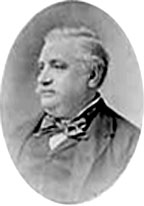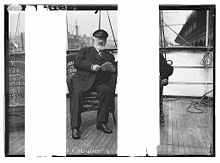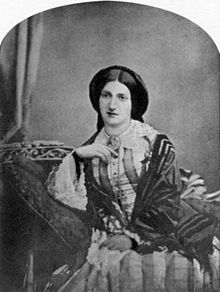Egg Benedict
Charles Ranhofer
Eggs Benedict" - 1860s -Credit is given to Delmonico's Restaurant, the very first restaurant or public dining room ever opened in the United States. In the 1860's, a regular patron of the restaurant, Mrs. LeGrand Benedict, finding nothing to her liking and wanting something new to eat for lunch, discussed this with Delmonico's Chef Charles Ranhofer (1836-1899),

Chef Charles Ranhofer
 Ranhofer came up with Eggs Benedict. He has a recipe called Eggs a' la Benedick (Eufa a' la Benedick) in his cookbook called The Epicurean published in 1894.:Eggs à la Benedick - Cut some muffins in halves crosswise, toast them without allowing to brown, then place a round of cooked ham an eighth of an inch thick and of the same diameter as the muffins one each half. Heat in a moderate oven and put a poached egg on each toast. Cover the whole with Hollandaise sauce.
Ranhofer came up with Eggs Benedict. He has a recipe called Eggs a' la Benedick (Eufa a' la Benedick) in his cookbook called The Epicurean published in 1894.:Eggs à la Benedick - Cut some muffins in halves crosswise, toast them without allowing to brown, then place a round of cooked ham an eighth of an inch thick and of the same diameter as the muffins one each half. Heat in a moderate oven and put a poached egg on each toast. Cover the whole with Hollandaise sauce.
OR .................

Commodore E.C. Benedict
Craig Claiborne, in September 1967, wrote a column in The New York Times Magazine about a letter he had received from Edward P. Montgomery, an American then residing in France. In it, Montgomery related that the dish was created by Commodore E.C. Benedict, a banker and yachtsman, who died in 1920 at the age of 86. Montgomery also included a recipe for eggs Benedict, stating that the recipe had been given to him by his mother, who had received it from her brother, who was a friend of the Commodore.[3]

Elizabeth David
Another origin of the dish is suggested in Elizabeth David's FRENCH PROVINCIAL COOKING Elizabeth David's French Provincial Cooking, where she describes a traditional French dish named œufs bénédictine, consisting of brandade (a puree of refreshed salt cod and potatoes), spread on triangles of fried bread. A poached egg is then set on top and napped with hollandaise. This story would also explain the distinctly French syntax, where the adjective follows, rather than precedes, the noun (although Oysters Rockefeller has the same syntax without needing a Romance-language origin). No one knows how this dish got to America but If Charles Ranhofer could have known of the œufs bénédictine and thought of the coincidence of the LeGrande's request and merged the two. Brilliant! The Canadian bacon or ham is probably preferred to the Salt Cod by MOST!
Elizabeth David's French Provincial Cooking, where she describes a traditional French dish named œufs bénédictine, consisting of brandade (a puree of refreshed salt cod and potatoes), spread on triangles of fried bread. A poached egg is then set on top and napped with hollandaise. This story would also explain the distinctly French syntax, where the adjective follows, rather than precedes, the noun (although Oysters Rockefeller has the same syntax without needing a Romance-language origin). No one knows how this dish got to America but If Charles Ranhofer could have known of the œufs bénédictine and thought of the coincidence of the LeGrande's request and merged the two. Brilliant! The Canadian bacon or ham is probably preferred to the Salt Cod by MOST!

Mrs. Isabella Beeton
Mrs Beeton's Book of Household Management (Oxford World's Classics) had recipes in the first edition (1861) for "Dutch sauce, for benedict" (p. 405) and its variant on the following page, "Green sauce, or Hollandaise verte", This gives me the idea that this belonged to the salt cod, That Mrs. David writes about. This would have been the perfect Lent or Friday Catholic dish as well so would have been popular.
had recipes in the first edition (1861) for "Dutch sauce, for benedict" (p. 405) and its variant on the following page, "Green sauce, or Hollandaise verte", This gives me the idea that this belonged to the salt cod, That Mrs. David writes about. This would have been the perfect Lent or Friday Catholic dish as well so would have been popular.
http://kitchenproject.com/history/EggsBenedict/
Eggs Benedict" - 1860s -Credit is given to Delmonico's Restaurant, the very first restaurant or public dining room ever opened in the United States. In the 1860's, a regular patron of the restaurant, Mrs. LeGrand Benedict, finding nothing to her liking and wanting something new to eat for lunch, discussed this with Delmonico's Chef Charles Ranhofer (1836-1899),

Chef Charles Ranhofer
 Ranhofer came up with Eggs Benedict. He has a recipe called Eggs a' la Benedick (Eufa a' la Benedick) in his cookbook called The Epicurean published in 1894.:Eggs à la Benedick - Cut some muffins in halves crosswise, toast them without allowing to brown, then place a round of cooked ham an eighth of an inch thick and of the same diameter as the muffins one each half. Heat in a moderate oven and put a poached egg on each toast. Cover the whole with Hollandaise sauce.
Ranhofer came up with Eggs Benedict. He has a recipe called Eggs a' la Benedick (Eufa a' la Benedick) in his cookbook called The Epicurean published in 1894.:Eggs à la Benedick - Cut some muffins in halves crosswise, toast them without allowing to brown, then place a round of cooked ham an eighth of an inch thick and of the same diameter as the muffins one each half. Heat in a moderate oven and put a poached egg on each toast. Cover the whole with Hollandaise sauce. OR .................

Commodore E.C. Benedict
Craig Claiborne, in September 1967, wrote a column in The New York Times Magazine about a letter he had received from Edward P. Montgomery, an American then residing in France. In it, Montgomery related that the dish was created by Commodore E.C. Benedict, a banker and yachtsman, who died in 1920 at the age of 86. Montgomery also included a recipe for eggs Benedict, stating that the recipe had been given to him by his mother, who had received it from her brother, who was a friend of the Commodore.[3]

Elizabeth David
Another origin of the dish is suggested in Elizabeth David's FRENCH PROVINCIAL COOKING
 Elizabeth David's French Provincial Cooking, where she describes a traditional French dish named œufs bénédictine, consisting of brandade (a puree of refreshed salt cod and potatoes), spread on triangles of fried bread. A poached egg is then set on top and napped with hollandaise. This story would also explain the distinctly French syntax, where the adjective follows, rather than precedes, the noun (although Oysters Rockefeller has the same syntax without needing a Romance-language origin). No one knows how this dish got to America but If Charles Ranhofer could have known of the œufs bénédictine and thought of the coincidence of the LeGrande's request and merged the two. Brilliant! The Canadian bacon or ham is probably preferred to the Salt Cod by MOST!
Elizabeth David's French Provincial Cooking, where she describes a traditional French dish named œufs bénédictine, consisting of brandade (a puree of refreshed salt cod and potatoes), spread on triangles of fried bread. A poached egg is then set on top and napped with hollandaise. This story would also explain the distinctly French syntax, where the adjective follows, rather than precedes, the noun (although Oysters Rockefeller has the same syntax without needing a Romance-language origin). No one knows how this dish got to America but If Charles Ranhofer could have known of the œufs bénédictine and thought of the coincidence of the LeGrande's request and merged the two. Brilliant! The Canadian bacon or ham is probably preferred to the Salt Cod by MOST!
Mrs. Isabella Beeton
Mrs Beeton's Book of Household Management (Oxford World's Classics)
 had recipes in the first edition (1861) for "Dutch sauce, for benedict" (p. 405) and its variant on the following page, "Green sauce, or Hollandaise verte", This gives me the idea that this belonged to the salt cod, That Mrs. David writes about. This would have been the perfect Lent or Friday Catholic dish as well so would have been popular.
had recipes in the first edition (1861) for "Dutch sauce, for benedict" (p. 405) and its variant on the following page, "Green sauce, or Hollandaise verte", This gives me the idea that this belonged to the salt cod, That Mrs. David writes about. This would have been the perfect Lent or Friday Catholic dish as well so would have been popular.http://kitchenproject.com/history/EggsBenedict/
Comments
Post a Comment